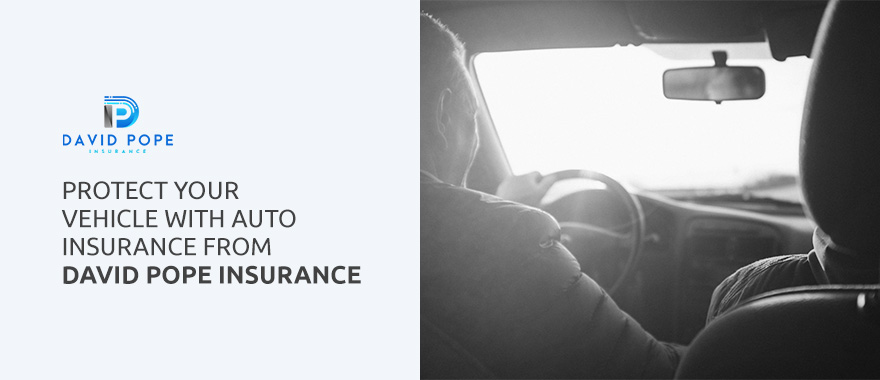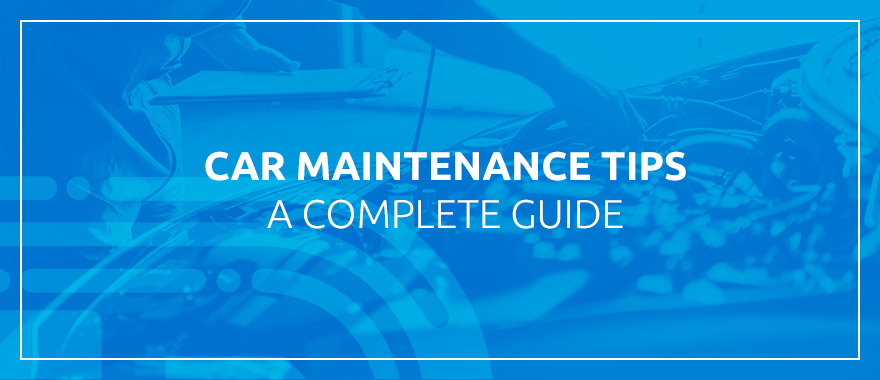
A car is a significant investment, and it’s in your best interest to take the time to maintain it. These machines have various components, filters and fluids that keep them running well. Like with any piece of heavy equipment, vehicle parts will eventually break down, and it’ll be up to you to ensure they get fixed.
Following a maintenance schedule is simple, even when you have no prior experience with cars. By proactively keeping your car in the best condition possible, you can increase your and others’ safety, boost your vehicle’s lifespan and save money that would otherwise go to costlier repairs. Continue reading for a comprehensive guide to car maintenance for beginners.
The first step you should take is to familiarize yourself with your car — and you can do so with the owner’s manual. These informative guides are located in the glove box or online via your car manufacturer’s website. Take some time to skim through the manual, highlighting any sections that don’t make sense to you so you can review them.
This pamphlet will outline all of the components and features of your car, from its cabin to under the hood. Some cars have extra compartments, hidden plugs and other features that can be helpful, so understanding where each part is located can improve your driving experience. Additionally, the manual will come with guidelines on how to properly maintain your specific car.
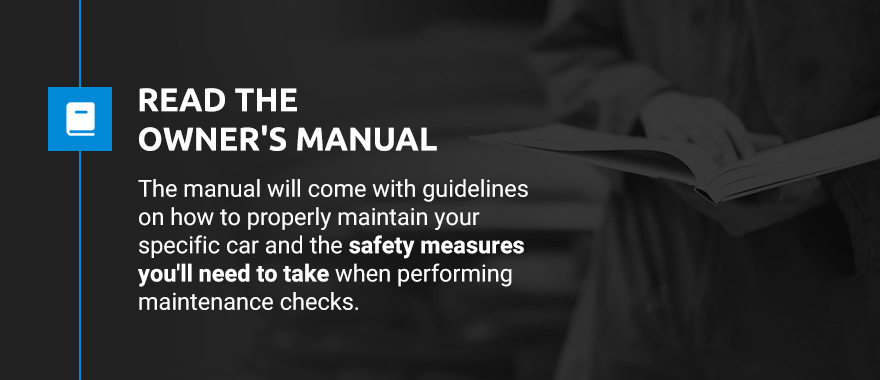
These guidelines will likely include a maintenance checklist, a maintenance schedule and any other information you need to maintain your car. This information may include the type of oil your car needs, how often to change the filters and belts and the safety measures you’ll need to take when performing maintenance checks. Be sure to research any maintenance variables you don’t understand.
There will also be a schedule that tells you when to replace certain parts and when to bring your car to a mechanic for a checkup. To ensure your car works well for years, it’s recommended that you follow the timeframes outlined in your owner’s manual. For example, you’ll likely need to bring your car in at 50,000 miles to change the brake pads. Keep an eye on that timeline to ensure you’re staying on top of your car’s maintenance.
Performing frequent basic maintenance checks on your car can help you identify potential issues before they become dangerous or costly. The last thing anyone wants is having to empty their savings to repair extensive damage that was easily preventable. These checks can take as little as 60 seconds, and the more you do them, the easier it’ll be to identify potential issues.
Aim for checking the following elements every week:
If you notice any irregularities from your previous checks, you may want to call your mechanic to schedule an appointment.
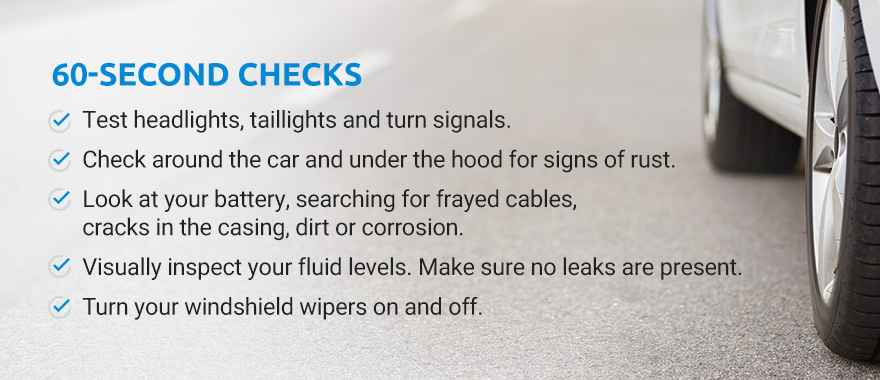
There are certain concerns you must attend to as soon as possible. The following issues can result in safety risks, engine damage and/or a ticket, so it’s critical to fix them immediately. If you’re unsure whether you need to fix a specific issue, ask your mechanic for guidance.
A car’s check engine light turns on when the electronic control system has run into one or more problems it can’t fix. This could be the result of an engine misfire, faulty gas cap or numerous other engine issues. Some people are tempted to simply ignore the light, fearing expensive diagnostic and repair bills. However, engine issues can result in dangerous safety risks, such as an overheating catalytic converter.
If your car’s engine light stays on for a few days in a row, you should make an appointment with your mechanic. If the light is flashing, your car needs attention immediately. At the auto shop, your mechanic will use a code reader to diagnose the issue so they can repair it properly.
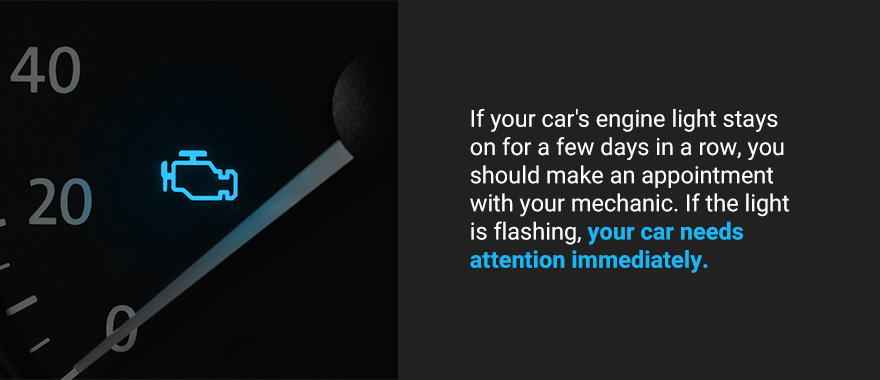
If your tire pressure light comes on, you’ll need to put air in one or more of your tires. To check your tire pressure, you’ll need a tire pressure gauge. Look around the inside of your driver’s side door for a sticker that indicates how much air in pounds per square inch your tires need. After you check each tire’s pressure, you can compare the numbers to determine how much air your tires need.
Fill up the deflated tires with an air compressor, which you can find at a local gas station. Keeping your tires at the correct pressure is the best way to maximize gas mileage and avoid a blowout.
A car’s headlights, taillights and turn signals are crucial for safety reasons — so much so that you can get a ticket for failing to use them. If one of them breaks, you need to replace it immediately. This way, you can avoid a pricey ticket and ensure other drivers can see you on the road.
Having old or faulty wiper blades can make it dangerous to drive in the rain, as your visibility will be impaired. This scenario puts you and others at risk. If you’re finding it hard to see when you’re driving in the rain, even when you’re using your wipers, you should replace them. It’s also important to install new blades when they don’t work at high speeds — a sudden downpour could become unnecessarily dangerous.
Every car requires a number of fluids to run properly. Below, you’ll find the fluids you need to check regularly and top off whenever they’re low. Read your owner’s manual to learn more information about the fluids your vehicle uses.
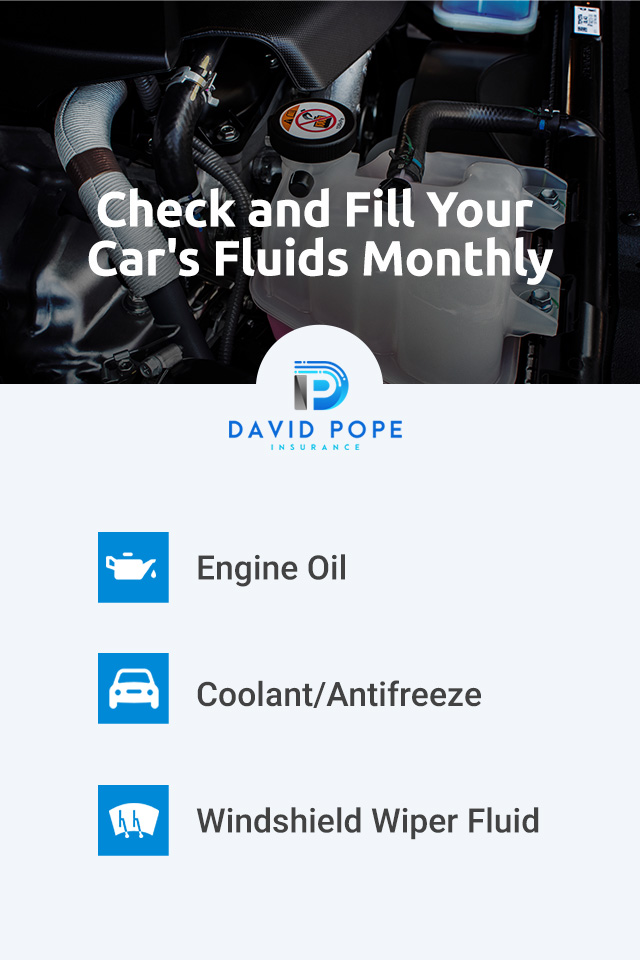
Check your engine oil level at least every month to make sure it isn’t running low. When the oil runs low, your engine’s parts will grind together and cause damage. Fortunately, checking your oil is a simple task.
Open the hood of your car to locate the oil dipstick. Pull it all the way out. Wipe the dipstick clean with a paper towel or rag. Then, reinsert the dipstick, remove it and look at the end. The oil level should be between the two dots at the end of the dipstick. If it’s below the lower dot, your oil level is too low, and you’ll need to add the correct type of oil to protect your engine. Take it to your mechanic for an oil change as soon as you can.
Additionally, vehicles need coolant/antifreeze to run properly. There should be a semi-translucent plastic container near your engine with two marks on it. There’ll be one line for “full” or “max” and another for “low” or “min”. The fluid should be somewhere between either line.
Typically, coolant is a bright color, like blue, yellow or green. If your car’s coolant looks brown or sludgy, you may need to consult your mechanic and replace the coolant. While topping off your coolant is easy, you should have a professional do a replacement when it’s gone bad. Whenever you top off your coolant, make sure you read and follow the instructions on the bottle. Some coolant must be diluted first.
Though it may seem less important, windshield wiper fluid is a critical element you need to check and refill. Like your car’s coolant, you’ll find a wiper fluid bottle under your car’s hood that you can visually inspect. If the levels fall below the lowest line, you’ll need to add more windshield wiper fluid. As with coolant, some wiper fluids may need to be diluted. Always read the instructions on the bottle and review your owner’s manual before getting started.
Check your tires thoroughly about every month. Every day, your tires are constantly being worn down and subject to damage. Maintaining your tires prevents blowouts and sliding in the rain and snow so you can keep yourself and others safe on the road. Inspecting your tires should be part of your monthly car maintenance schedule.
If you’re unsure of your tires’ age, you should check that information first. Look for the DOT stamp on the tire. The last four digits are the date the tires were manufactured. The first two digits are the week, and the last two indicate the year. Get your tires replaced, regardless of tread and lack of damage, between six and 10 years after the date of manufacture.
As mentioned above, your car will turn on a tire pressure light when one or more of the tires don’t have enough air. However, it’s a good idea to fill up your tires each month so they never get that low. On average, tires lose about 1 pound per square inch of air each month, and a bit more in cold weather. By checking your tire pressure and topping off low tires monthly, you can stay ahead of related issues.
A tire’s treads are what give the tire traction on the road. While important for driving normally, having thick tire treads is critical for driving in rain or snow. Check your tire tread depth using the penny test. Stick a penny into a tire’s tread so that the head side is stuck straight into it. If you can still see the top of Abraham Lincoln’s head, you need to replace your tire.

Visually inspect each tire for signs of damage. Look for any cuts, punctures, bumps or cracks throughout the tires. If you spot something that might be a concern, you can give your mechanic a call for advice on how to proceed.
Think of your car’s oil as its lifeblood — motor oil reduces friction, keeps your engine running smoothly and protects your engine from damage. An engine filter helps remove contaminants from engine oil that would otherwise get into the engine.
The owner’s manual will discuss how often to change your engine oil and filter. There will be a recommendation for miles and months. For example, you may need to change them every 5,000 miles or every 6 months. The oil you put in your car could also affect how much it should be changed. For instance, regular oil may not last as long as synthetic. Both the way you drive and how often you drive will also affect the timing.
Ultimately, it’s better to have a mechanic change your oil sooner rather than later.
The car’s air filter is also something that needs to be replaced on a regular basis. When you get your oil changed, you should also ask your mechanic to check your air filter. As a baseline, it should be changed about every 15,000 to 20,000 miles, but the exact number will vary greatly depending on where you live and drive.
Of course, living in a dustier area will require you to change your filter often, potentially once or twice a year. In areas with cleaner air, you may only need to do so every three years. If you check your filter each time your oil is changed, you’ll be able to better estimate how often it needs to be changed.
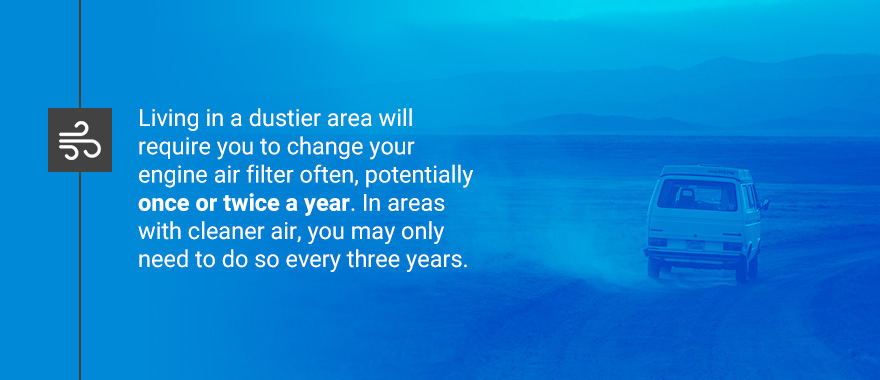
Because your tires can wear down unevenly, it’s helpful to get your tires rotated every so often. Check your owner’s manual to make sure your car has wheels and tires that should be rotated. If you neglect to rotate your tires, you’ll have uneven tires that can make your drive rough and unstable. Having uneven tires will put you at a higher risk of hydroplaning and losing traction.
When you go to get your tires rotated, you should first know whether you have directional tires. These tires are a special type of tire with a unique tread pattern that should only be driven in one direction. These tires offer better control, performance and safety, but they can only be rotated front to back. If you’re unsure, you can ask your mechanic to check.
If you want to go above and beyond routine maintenance, you can even learn how to examine your belts and hoses. There are several belts and hoses under the hood, and all of them serve an important purpose. Inspect them regularly to make sure they’re in good condition.
All hoses should be firmly attached and not have cracks or bulges. Most cars and SUVs have a timing belt, which is critical for your engine to function properly. If it appears worn down or exhibits cracking, missing material or glazing, you’ll need to get it replaced as soon as possible.
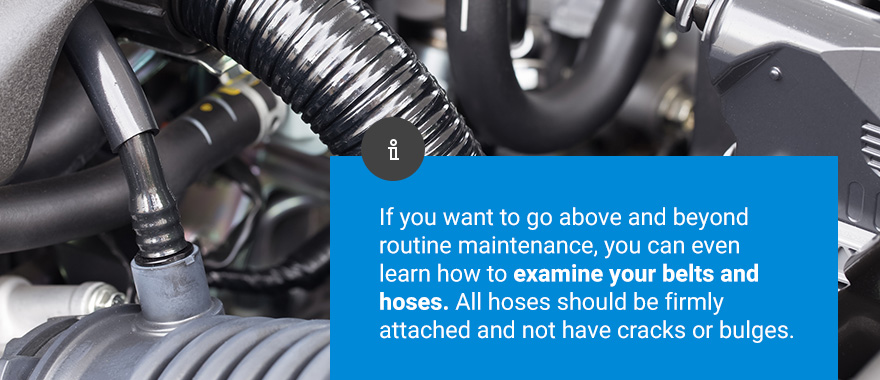
There are a few other tasks you should be aware of to keep your car in great condition.
Be sure to keep an eye on your car’s battery. If you continue to check it and notice the voltage starting to drop, you may need to consider a new battery. Some batteries need to be replaced every two to three years, while others can last five to six years or longer.
It goes without saying that brakes are a fundamental part of your car. Unfortunately, people often don’t get their brakes changed until it’s too late and the rotors are damaged. If you start hearing squeaking, squealing or grinding from your brakes, you should get them checked out as soon as you can. Ideally, you should have your brakes changed before they start squeaking, so once you start hearing it, it’s time to visit your mechanic.
A car’s heating, ventilation and air conditioning (HVAC) system works alongside an air filter to help keep your cabin clean and free of dust, pollen and other allergens. The cabin air filter should be changed about as often as the engine air filter, which is every 12,000 to 15,000 miles, depending on where you live.
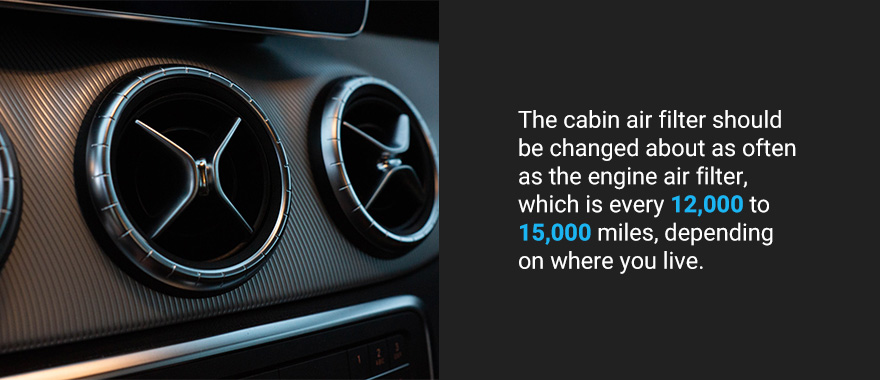
When your car is out of alignment and you don’t get it fixed, your axles can become seriously damaged. If your car starts veering to one side or rattling at high speeds, your car is likely unaligned. Ask your mechanic to check your alignment. Having proper vehicle alignment can reduce uneven tire wear and increase gas mileage and handling.
Don’t forget to clean your car’s exterior to prevent rust and damage. Be sure to wash your car at least twice a year. If you consistently drive on muddy or otherwise dirty roads, you’ll likely need to clean your car more often. Either wash your car yourself or take your car to a car wash to ensure it’s freshly washed.
Protecting your car with auto insurance is just as important as maintaining it. Because you can never know what can happen on the road, auto insurance is an essential aspect of keeping you and your car covered in case of an accident. In fact, car insurance is required by law in almost every state.
David Pope Insurance Services, LLC can help you find the lowest rates for home, auto, life and even commercial insurance. We’re your one-stop shop for insurance agents in and around Union, Missouri. We offer flexible and customized free quotes that can suit your needs and budget, so reach out today.
